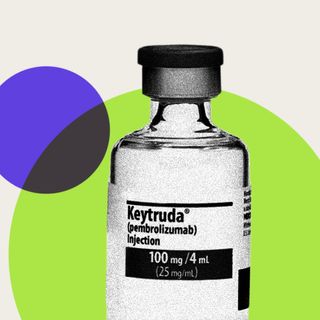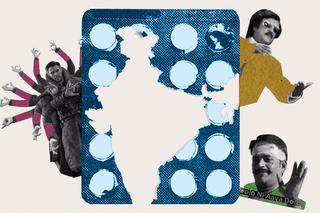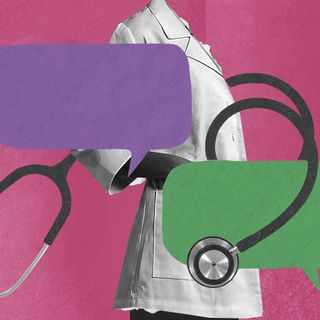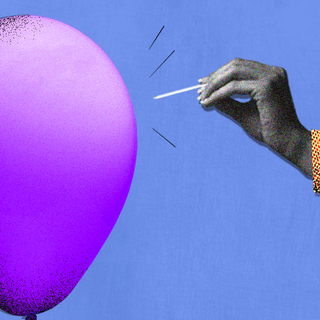
Dolo‑650 is India’s Favorite Medicine – and Meme. What Could Go Wrong?
When internet culture intersects with public health, the line between education and misinformation gets blurred.

Some proclaim it to be the most delectable “snack,” while others liken it to candy. As we enter the third year of an endlessly exhausting pandemic, a new character has entered the chat – Dolo-650.
While the momentum of the Dolo pill matches the force of Rajinikant’s hand as he pops it into his mouth in a snappy reel, Uday Shetty from Welcome (2007) is seen selling Dolos, instead of his famous “kandas,” in another. Paro from Devdas (2002) too is now dancing not to “Dola Re” but “Dolo Re.” An entire subculture on the internet is now dedicated to “memeifying” and, inadvertently, popularising this over-the-counter drug.
Most households today have their own Dolo stories. Some have used it for years; the medicine occupies bedside tables and drawers, patiently biding its time. Some chanced upon the tablet because of a doctors’ prescription, others saw the internet gush over its powers against Omicron variant’s two horsemen – flu and body ache.
But everything comes with fine print – especially medicine. “It is essential to note [Dolo] is no magic pill – it does not cure anything, simply provides symptomatic pain relief,” says Dr. Siddhi Chaudhari, a public health researcher who previously worked as a medical officer at a Covid19 ward. When internet culture intersects with public health, the line between education and misinformation gets blurred.
***
“We’re having a pandemic for the first time, so the whole universe taking it together is what makes Dolo so big right now,” says Dr. Lancelot Pinto, a pulmonary disease specialist at P.D. Hinduja Hospital, Mumbai. A look at the numbers illustrates just how big the craze is: by November 2021, Bengaluru-based manufacturer Micro Labs, which sells Dolo-650, had sold 145 million strips (2.2 billion tablets). According to data from the research firm IQVIA, these numbers are double the amount sold in 2019.
Dolo-650 is the brand name for 650 mg of paracetamol, which is an antipyretic (for fever) and analgesic (for pain relief). Paracetamol itself has long flowed through Indian households like tap water, used to treat malaria and dengue infections, cold, and cough, along with being distributed across public health centers. But the vagaries of the pandemic cemented the popularity of Dolo, making it the “brand of great utility and ubiquity for many,” as brand strategist Harish Bijoor put it.
“Where no other drugs worked and variants after variants recurred, Dolo stayed constant and the common masses’ trust on it as a ‘wonder drug’ solidified.,” Dr. Chaudhari tells me.
Related on The Swaddle:
Brand-name drugs have always been important in medicinal history, capturing both the attention and frenzy of people by becoming synonymous with an illness. There was Saridon of the “Sirf ek Saridon, aur Sardard se aaraam!” jingle fame for pain relief. And who can forget Crocin, Dolo’s predecessor and now-nemesis. Marvyn Paul, 26, calls it the “Zoom vs Skype – but for medicines.”
But Crocin got too popular. Whenever a drug becomes “generic,” doctors face the pressure of prescribing a different brand version than what patients already know. If a patient sees the doctor prescribing something as unexceptional as Crocin, Dr. Pinto explains, they may feel encouraged to self-medicate themselves, thinking Crocin is something they could have taken themselves. There was thus a void – a need for a fancier version of paracetamol to take it to the next level.
***
Pop culture can be an interesting tool for raising awareness. “Not everyone has the time and education to go through academic papers,” says Dr. Shivangi Shankar, a modern medicine doctor. “So, it helps to have easily accessible information in the form of, let’s say, Instagram reels.”
Research notes how humor in pharmaceutical advertisements helps the audience connect with the issue and remove psychological barriers. A study from October last year found Covid19-related memes helped people cope emotionally, making people feel “calm,” “psychologically safer,” and “better able to pay attention to the underlying messages related to health threats.”
As Stuti Govil, 30, says, “I think we’ve all gone stir crazy with this unending pandemic, and we deserve some laughs, no?”
However, the spirit of education and “good fun” can quickly morph into misinformation and abuse of medicines when the illusion is one of a magic pill that cures everything.
Once upon a time, in the early 2000s, the aspirin brand Alka-Seltzer was quite the belle of the ball. Books and television presented a world where powerful and important men would simply pop an Alka-Seltzer into water and drink it if they ever had a headache. “I think it left a lot of impression on the people watching as it became a cool thing to do,” says Dr. Pinto.
Dolo’s story is a pale echo of this. Memes and reels have made the brand ubiquitous, which subsequently drives self-medication. Where brand names become the point of conversation rather than the drug itself, “it makes medication seem like a rather casually consumable commodity,” Dr. Shankar notes. This can radically affect the dosage and make people more liberal with self-medication.
Now, we know paracetamol is largely a reliable medicine; it is a safe drug when consumed in moderation. It does not decrease platelets, has a good analgesic effect, and is available at reasonable rates.
However, public health researcher Bijaya Biswal points out that paracetamol’s “efficacy in popular understanding for chronic pain is overestimated.” For instance, paracetamol doesn’t work for chronic pain any more than a placebo.
Another burgeoning concern is that, in case medicines are consumed at inappropriate doses, they may cause harm or not work after a certain point in time. “It’s not like paracetamol is absolutely safe. When the entire population uses paracetamol together without any limitations whatsoever, you will potentially see the rarer side effects that happen,” Dr. Pinto points out. These include liver and/or kidney damage. There is anecdotal and some statistical evidence to show how people’s tolerance to Dolo-650 has increased, rendering the medicine ineffective. Moreover, since the brand usually sells at specific doses, people tend to stick to that instead of considering their individual needs. In this scenario, prescriptions become irrelevant.
Related on The Swaddle:
Antibiotic Overuse is Driving Drug‑Resistant Bacteria in India: ICMR
Distilling healthcare information into short forms such as memes or videos loses much of the nuance central to medicine. Dr. Shankar notes the majority of the time patients may not even need medicines. “These things require patient dialogue which is not possible within these limited formats.” Eventually, people may lose faith in these rather useful medicines. “This is a fast-paced world and people expect quick cures,” argues Dr. Chaudhari. Any viral infection has a specific biological time frame, an incubation period, a symptomatic phase, and then recovery. “You cannot skip through the stages, despite the potency of your medicines.”
What makes the pop-cultural popularity unique in the Indian setup is the lack of a single, trusted source of health information to obtain information about drugs, their safety profiles, or medical conditions. In the U.K., for instance, the NHS website lists necessary and very precise information about different conditions. This “means people are not relying on random Googling for medical info or misinformation through WhatsApp messages,” Biswal explains. “Since we don’t have such a system, a lot of our information related to medicines might come directly from doctors or other patients using the same drugs.”
“Memes/reels don’t exist in silos. They initiate discussion and those discussions, too, add to the ‘infodemic.’ Antibiotics aren’t that far a reach in these conversations,” says Dr. Shankar.
Dr. Shankar is referring to the fact that Dolo-650 is only one drug that is normalized; the excessive use of antibiotics like azithromycin for any symptoms of cold/swollen tonsils or the household use of ivermectin are critical case studies. People continued to take medications – with or without prescriptions, in the absence of evidence – unaware the use of some has been clearly refuted as being ineffective against Covid.
“That’s the flip side of self-medication,” Dr. Pinto says. “You don’t know when to start, when to stop, what the red flags are – you don’t know what you need to watch out for.” It contributes to a crisis of credible information, and makes people lower their guards. Only recently, a Lancet study found an alarming rise of antimicrobial resistance in India; more than 1.2 million people died from drug-resistant infections in 2019 owing to unflinching use of antibiotics and antivirals especially during Covid19.
More importantly, this “pop-medication” speaks to the heart of why pharmaceutical advertising is a restricted and unethical territory. Industry experts point out that since paracetamol is a scheduled drug, it cannot be advertised and promoted under the Drugs and Magic (Objectionable Advertisement) Act, 1954.
But online pop culture exists as a grey area where regulations and ethics are pushed to the margins. During the pandemic, several health professionals used Instagram reels to talk about how it only took a Dolo to cure their Covid19. “That in principle is unethical,” Dr. Pinto clarifies, “because as a medical professional, you aren’t allowed to advertise a brand. You can say paracetamol if you want, but you’re not allowed to say Dolo.”
“When it comes to social media and healthcare, the questions of accreditation and accountability arise,” Dr. Chaudhari points out. If a person chooses to incorrectly self-diagnose and medicate based on the limited knowledge they gain from social media – who will be held accountable?
***
Dr. Pinto believes Dolo’s moment in the sun may “be over at some point of time because Dolo will become generic.” But this is as much about Dolo, as it is about the azithromycins, ivermectins, health supplements, and the several other antibiotics and antivirals whose side effects we’ve chosen to overlook.
The rise of Dolo only presents the consequences of a mishmash of misinformation, self-medication, and branding healthcare. “Things that were supposed to be purely in the realm of healthcare are now assuming household importance,” Dr. Chaudhary says.
This marriage of public health and pop culture needs some regulations, some restraint, and most of all – accountability. If there were a rule book for sharing health memes and pop culture literature, chapter one would then be on including an advisory to consume medicines under medical guidance. Other additions could be mentioning the source of information (from an accredited medical professional or health organization such as WHO), warnings for side effects, and so on.
“I can confidently say that people, unfortunately, have a very ambiguous idea about the limits of medication. Not just Dolo, but all medications in general,” Dr. Chaudhari concludes. “Like all other things, allopathy, drugs, and the human body have their own limits – and we must accept those first.”
Saumya Kalia is an Associate Editor at The Swaddle. Her journalism and writing explore issues of social justice, digital sub-cultures, media ecosystem, literature, and memory as they cut across socio-cultural periods. You can reach her at @Saumya_Kalia.
Related


Body Matters: Navigating Asexuality in a Gynaec’s Office
